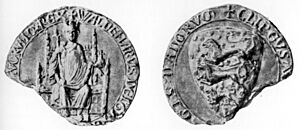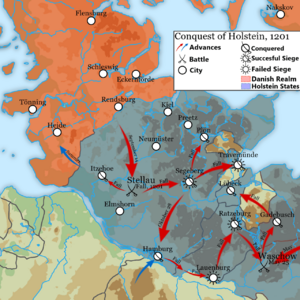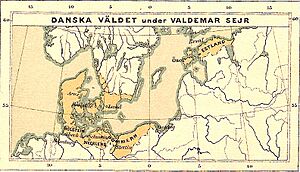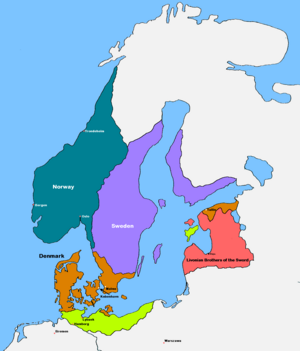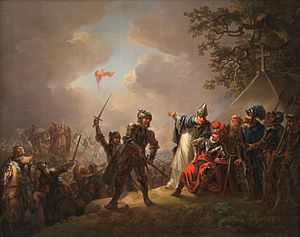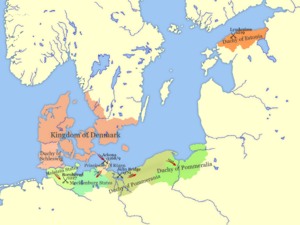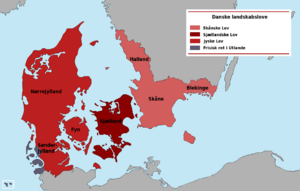Valdemar II of Denmark facts for kids
Quick facts for kids Valdemar II |
|||||
|---|---|---|---|---|---|
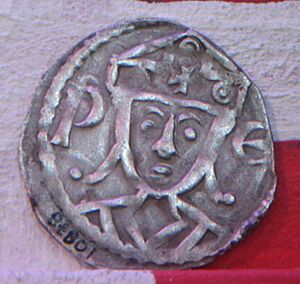
Coin minted for King Valdemar II, Lund University History Museum
|
|||||
| King of Denmark and the Wends | |||||
| Reign | 1202–1241 | ||||
| Predecessor | Canute VI | ||||
| Successor | Eric IV | ||||
| Junior kings | Valdemar the Young, 1218–31 Eric IV, 1231–41 |
||||
| Born | 28 June 1170 Ribe, Jutland, Denmark |
||||
| Died | 28 March 1241 (aged 70) Vordingborg Castle, Vordingborg, Denmark |
||||
| Burial | St. Bendt's Church, Ringsted, Denmark | ||||
| Spouse | Dagmar of Bohemia Berengária of Portugal |
||||
| Issue among others... |
|
||||
|
|||||
| House | Estridsen | ||||
| Father | Valdemar I of Denmark | ||||
| Mother | Sophia of Minsk | ||||
Valdemar II Valdemarsen (born June 28, 1170 – died March 28, 1241) was a powerful Danish king. He is often remembered as Valdemar the Victorious (Valdemar Sejr). He ruled Denmark from 1202 until his death in 1241.
During his reign, Valdemar II greatly expanded Denmark's lands. He conquered areas like Lybeck and Holstein. He also helped settle who would be king in Norway, making Norway owe loyalty to Denmark. Valdemar was also known for creating new laws, like the Code of Jutland. This code was used in Denmark for many years.
Contents
Early Life and Challenges
Valdemar was the second son of King Valdemar I of Denmark. When his father died, Valdemar was only 12 years old. He became the Duke of Southern Jutland.
His guardian was Bishop Valdemar Knudsen. This bishop was very ambitious. He tried to take the Danish throne from Valdemar's older brother, King Canute VI of Denmark. Bishop Valdemar even got help from German nobles.
Duke Valdemar quickly saw the danger. He invited the bishop to a meeting, but the bishop ran away to Norway. The bishop then gathered a fleet of 35 ships and attacked Denmark's coasts. He claimed he should be king. In 1193, King Canute VI captured Bishop Valdemar. He was held prisoner for many years until 1206. He was released only after promising not to cause trouble in Denmark again.
Valdemar also faced another enemy, Count Adolf III of Holstein. Count Adolf tried to get other German leaders to take southern Jutland from Denmark. He also supported Bishop Valdemar's plan to become king.
With the bishop in prison, Duke Valdemar went after Count Adolf. Valdemar marched south and captured Adolf's new castle. He defeated and captured Count Adolf in a battle in 1201. Adolf was put in a prison cell next to Bishop Valdemar. Two years later, Count Adolf became sick. He bought his freedom by giving all of Schleswig, north of the Elbe River, to Duke Valdemar.
In November 1202, Valdemar's older brother, King Canute VI, died unexpectedly. He had no children.
Becoming King and Expanding Denmark
After his brother's death, Duke Valdemar was made king at the Jutland Assembly. At this time, the Holy Roman Empire was in a civil war. Two rivals were fighting to be emperor. Valdemar II sided with Otto IV against King Philip.
In 1203, Valdemar invaded and conquered Lybeck and Holstein. These lands became part of Denmark. In 1204, he tried to influence who would be the next king of Norway. He led a Danish fleet and army to Norway to support a claimant to the throne. This led to a war that lasted until 1208. In the end, the Norwegian king had to show loyalty to the king of Denmark.
Valdemar II also had disagreements with the Pope and church leaders. He wanted to choose who became important church officials in certain areas. These conflicts showed how powerful Valdemar was becoming. He even appointed his close friend, Nicholas I, as the Bishop of Schleswig and later as Chancellor of Denmark.
Valdemar continued to expand his power in Germany. He captured cities like Stade and Hamburg. He made alliances and fought battles to secure Denmark's control over these areas. Eventually, Valdemar supported Emperor Frederick II. In return, the emperor recognized Denmark's rule over Schleswig, Holstein, and other lands like Pomerania.
The Battle of Lindanise
In 1219, the Livonian Knights, who were trying to spread Christianity in the eastern Baltic, asked Valdemar for help. Pope Honorius III even called Valdemar's invasion of Estonia a crusade. Valdemar gathered a huge army and 1500 ships to sail east.
When the army landed in Estonia, near what is now Tallinn, the Estonian chiefs met with the Danes. They agreed to accept the Danish king as their ruler. Some of them even chose to be baptized. This seemed like a good sign.
However, three days later, on June 15, 1219, while the Danes were at church, thousands of Estonians suddenly attacked their camp. There was a lot of confusion, and things looked bad for Valdemar's army. Luckily, Vitslav of Rügen and his men attacked the Estonians from behind.
During the Battle of Lindanise, a famous legend says that a red flag with a white cross fell from the sky. A voice was heard saying, "When this banner is raised on high, you shall be victorious!" This flag, called the Dannebrog, became the national flag of Denmark. It is the oldest flag design in Europe still used today. The Danes won the battle, and Estonia became part of the Danish kingdom.
Valdemar ordered a large fortress to be built at Reval, near the battle site. A city grew around this castle, and it is still called Tallinn, which means "Danish-castle/town" in Estonian.
Loss of German Lands
In 1223, King Valdemar and his oldest son, Prince Valdemar, were kidnapped. Count Henry I of Schwerin captured them while they were hunting. Count Henry demanded that Denmark give back the lands it had conquered in Holstein. He also wanted Denmark to become a vassal (a loyal servant) of the Holy Roman Emperor.
Danish officials refused these demands, and Denmark declared war. While Valdemar was in prison, many German areas broke away from Danish rule. Danish armies tried to keep control, but they were defeated in 1225. To be released, Valdemar had to agree to give up the German lands. He also had to pay a huge amount of silver (44,000 marks) and promise not to seek revenge on Count Henry.
Valdemar immediately asked the Pope to cancel his promise, saying he was forced to make it. The Pope agreed. Valdemar then tried to get his German lands back. He made a treaty with his nephew and marched south. However, his luck ran out. A series of defeats, ending with the Battle of Bornhöved in 1227, confirmed the loss of Denmark's northern German territories.
Later Years and New Laws
After losing the German lands, King Valdemar II focused on improving things within Denmark. He introduced a feudal system. This meant he gave land to men who, in return, promised him service. This made the noble families more powerful. Free farmers, who had enjoyed many rights since the Viking Age, lost some of their old freedoms.
King Valdemar II spent the rest of his life creating a new set of laws for different parts of Denmark: Jutland, Zealand, and Skåne. These laws were used as Denmark's main legal code until 1683. This was a big change from the old system where each region made its own laws.
The new laws also outlawed old ways of deciding guilt, like trial by ordeal (where someone was tested with fire or water) and trial by combat (where people fought to prove innocence). The Code of Jutland was approved in 1241, just before Valdemar died at Vordingborg Castle. Valdemar was buried next to his first wife, Queen Dagmar, in Ringsted.
Family Life
Valdemar had two important marriages.
He first married Dagmar of Bohemia in 1205. She was also known as Margaret of Bohemia. She quickly became very popular with the Danish people. Valdemar and Dagmar had one son, Valdemar the Young, who was made co-king in 1218. Sadly, Valdemar the Young died in a hunting accident in 1231. Queen Dagmar died in childbirth in 1212. Old folk songs say that on her deathbed, she warned Valdemar not to marry Berengaria of Portugal, predicting trouble for Denmark.
After Dagmar's death, Valdemar married Berengária of Portugal in 1214. She was the daughter of King Sancho I of Portugal. Queen Berengária was beautiful, but many Danes did not like her because they thought she was hard-hearted. She also died young in childbirth in 1221.
In Danish songs and stories, Dagmar is seen as the kind and popular queen, while Berengária is seen as beautiful but proud.
Children
With his first wife, Dagmar of Bohemia, Valdemar had:
- Valdemar the Young of Denmark (1209–1231)
- A son who was stillborn (1212)
With his second wife, Berengária of Portugal, Valdemar had:
- Eric IV, King of Denmark (1216–1250)
- Sophie of Denmark (1217–1247)
- Abel, King of Denmark (1218–1252)
- Christopher I, King of Denmark (1219–1259)
- A stillborn child (1221)
Remembering Valdemar II
Valdemar is a very important figure in Danish history. He is known as "the king of the Dannebrog" (the Danish flag) and as a great lawmaker. The difficult times and civil wars that followed his death made people look back at his reign as a "golden age."
Since 1912, June 15 has been officially called Valdemarsdag (Valdemar's Day). This date is now one of the 33 Danish annual Flag Days when the Dannebrog is raised in celebration.
The 1997 film Eye of the Eagle tells a fictional story about Valdemar the Young. His father, King Valdemar, was played by Lars Lohmann in the movie.
In Tallinn, the capital of Estonia, there is a park called the Danish King's Garden. This is where the Danish flag Dannebrog is said to have fallen from the sky. Every year on June 15, the Day of the Danish Flag is celebrated in this garden.
Images for kids
See also
 In Spanish: Valdemar II de Dinamarca para niños
In Spanish: Valdemar II de Dinamarca para niños


